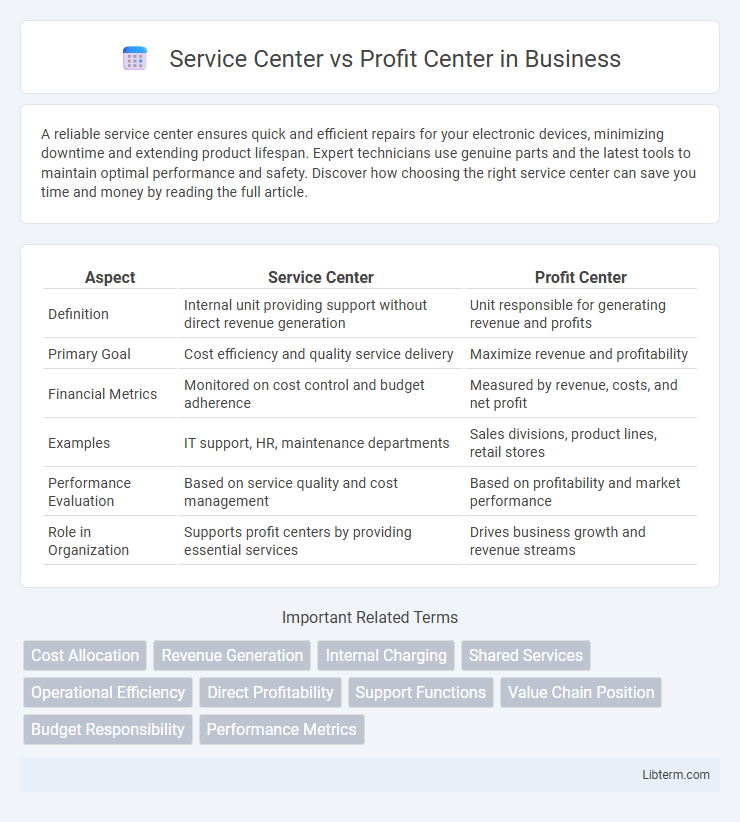A reliable service center ensures quick and efficient repairs for your electronic devices, minimizing downtime and extending product lifespan. Expert technicians use genuine parts and the latest tools to maintain optimal performance and safety. Discover how choosing the right service center can save you time and money by reading the full article.
Table of Comparison
| Aspect | Service Center | Profit Center |
|---|---|---|
| Definition | Internal unit providing support without direct revenue generation | Unit responsible for generating revenue and profits |
| Primary Goal | Cost efficiency and quality service delivery | Maximize revenue and profitability |
| Financial Metrics | Monitored on cost control and budget adherence | Measured by revenue, costs, and net profit |
| Examples | IT support, HR, maintenance departments | Sales divisions, product lines, retail stores |
| Performance Evaluation | Based on service quality and cost management | Based on profitability and market performance |
| Role in Organization | Supports profit centers by providing essential services | Drives business growth and revenue streams |
Understanding Service Centers and Profit Centers
Service centers are internal business units that provide support services such as IT, HR, or maintenance to other departments, functioning without directly generating profit but helping optimize operational efficiency. Profit centers, on the other hand, are distinct units responsible for generating revenue and profits through sales or services, with direct accountability for financial performance. Understanding the difference between service centers and profit centers is crucial for effective cost control, resource allocation, and performance evaluation in organizational management.
Key Differences Between Service Centers and Profit Centers
Service centers primarily focus on supporting other departments by providing essential services without directly generating revenue, whereas profit centers are responsible for producing profits through sales and operational activities. Service centers are evaluated based on cost control and efficiency, while profit centers are assessed based on their ability to generate income and manage expenses. The key difference lies in their financial responsibility: service centers minimize costs, and profit centers maximize profits through revenue generation.
Roles and Responsibilities in Each Center
Service Centers primarily focus on providing support functions such as IT, HR, and maintenance, aiming to optimize internal processes and enable operational efficiency without generating direct revenue. Profit Centers are responsible for driving revenue by managing sales, marketing, and product development activities, with accountability for both generating income and controlling associated costs. Each center operates under distinct performance metrics, where Service Centers emphasize cost control and customer satisfaction internally, while Profit Centers concentrate on profitability and market growth.
Financial Impact on Organizations
Service centers typically function as cost centers, incurring expenses without directly generating revenue, which can impact an organization's profitability by increasing operational costs. Profit centers contribute directly to the bottom line by generating revenue and managing expenses, enhancing overall financial performance and enabling more precise profitability analysis. Effective differentiation between service and profit centers allows organizations to optimize resource allocation, cost control, and financial accountability.
Performance Metrics for Evaluation
Service centers are evaluated using performance metrics such as customer satisfaction, response time, and cost efficiency, emphasizing internal service quality and support effectiveness. Profit centers focus on financial metrics like revenue generation, profit margins, and return on investment, highlighting their ability to contribute directly to an organization's profitability. Comparing these metrics clarifies the distinct roles each center plays in achieving overall corporate objectives.
Cost Allocation Methods
Service centers typically use cost allocation methods such as step-down or reciprocal allocation to distribute overhead expenses to profit centers based on the usage of services provided. Profit centers directly generate revenue and absorb allocated costs from service centers to evaluate profitability accurately. Accurate cost allocation ensures transparent internal accounting and supports effective performance measurement within the organization.
Revenue Generation Strategies
Service centers optimize internal support functions to reduce costs and improve operational efficiency without directly generating revenue. Profit centers focus on revenue generation by managing both costs and income streams, often through market-driven strategies such as product diversification and customer acquisition. Effective revenue generation in profit centers requires aligning pricing models, sales incentives, and performance metrics to maximize profitability.
Challenges Faced by Service and Profit Centers
Service centers struggle with measuring performance and value since they do not generate direct revenue, making cost allocation and accountability complex. Profit centers face intense pressure to maximize profitability while balancing market competition, pricing strategies, and operational efficiency. Both centers grapple with resource optimization but differ as service centers prioritize cost control and support quality, whereas profit centers emphasize revenue growth and profit margins.
Aligning Business Goals with Center Type
Aligning business goals with the appropriate center type enhances organizational efficiency and financial clarity. Service centers focus on supporting other departments by optimizing operational processes and cost control, directly impacting overall productivity. Profit centers prioritize revenue generation and profitability, driving strategic initiatives that contribute to the company's bottom line and market competitiveness.
Choosing the Right Center Model for Your Business
Choosing the right center model for your business depends on your strategic goals and operational focus. Service centers are ideal for organizations aiming to centralize support functions and improve efficiency without direct profit accountability, whereas profit centers prioritize revenue generation and cost control, making them suitable for units expected to drive profitability. Evaluating factors such as financial accountability, performance metrics, and resource allocation helps determine whether a service center or profit center aligns better with your business objectives.
Service Center Infographic

 libterm.com
libterm.com